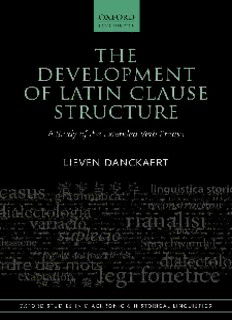Table Of ContentThe Development of Latin Clause Structure
OXFORDSTUDIES IN DIACHRONICANDHISTORICAL LINGUISTICS
GENERAL EDITORS:AdamLedgewayandIanRoberts,UniversityofCambridge
ADVISORY EDITORS:CynthiaAllen,AustralianNationalUniversity;RicardoBermúdez-
Otero, University of Manchester; Theresa Biberauer, University of Cambridge;
Charlotte Galves, University of Campinas; Geoff Horrocks, University of Cambridge;
Paul Kiparsky, Stanford University; Anthony Kroch, University of Pennsylvania;
David Lightfoot, Georgetown University; Giuseppe Longobardi, University of York;
George Walkden, University of Konstanz; David Willis, University of Cambridge
RECENTLY PUBLISHED IN THE SERIES
VerbMovementandClauseStructureinOldRomanian
VirginiaHillandGabrielaAlboiu
TheSyntaxofOldRomanian
EditedbyGabrielaPanăDindelegan
GrammaticalizationandtheRiseofConfigurationalityinIndo-Aryan
UtaReinöhl
TheRiseandFallofErgativityinAramaic
CyclesofAlignmentChange
EleanorCoghill
PortugueseRelativeClausesinSynchronyandDiachrony
AdrianaCardoso
Micro-changeandMacro-changeinDiachronicSyntax
EditedbyEricMathieuandRobertTruswell
TheDevelopmentofLatinClauseStructure
AStudyoftheExtendedVerbPhrase
LievenDanckaert
TransitiveNounsandAdjectives
EvidencefromEarlyIndo-Aryan
JohnJ.Lowe
Foracompletelistoftitlespublishedandinpreparationfortheseries,seepp.–
The Development of
Latin Clause Structure
A Study of the Extended Verb Phrase
LIEVEN DANCKAERT
1
OUPCORRECTEDPROOF–FINAL,18/4/2017,SPi
3
GreatClarendonStreet,Oxford,OXDP,
UnitedKingdom
OxfordUniversityPressisadepartmentoftheUniversityofOxford.
ItfurtherstheUniversity’sobjectiveofexcellenceinresearch,scholarship,
andeducationbypublishingworldwide.Oxfordisaregisteredtrademarkof
OxfordUniversityPressintheUKandincertainothercountries
©LievenDanckaert
Themoralrightsoftheauthorhavebeenasserted
FirstEditionpublishedin
Impression:
Allrightsreserved.Nopartofthispublicationmaybereproduced,storedin
aretrievalsystem,ortransmitted,inanyformorbyanymeans,withoutthe
priorpermissioninwritingofOxfordUniversityPress,orasexpresslypermitted
bylaw,bylicenceorundertermsagreedwiththeappropriatereprographics
rightsorganization.Enquiriesconcerningreproductionoutsidethescopeofthe
aboveshouldbesenttotheRightsDepartment,OxfordUniversityPress,atthe
addressabove
Youmustnotcirculatethisworkinanyotherform
andyoumustimposethissameconditiononanyacquirer
PublishedintheUnitedStatesofAmericabyOxfordUniversityPress
MadisonAvenue,NewYork,NY,UnitedStatesofAmerica
BritishLibraryCataloguinginPublicationData
Dataavailable
LibraryofCongressControlNumber:
ISBN––––
Printedandboundby
CPIGroup(UK)Ltd,Croydon,CRYY
LinkstothirdpartywebsitesareprovidedbyOxfordingoodfaithand
forinformationonly.Oxforddisclaimsanyresponsibilityforthematerials
containedinanythirdpartywebsitereferencedinthiswork.
Contents
Seriespreface ix
Acknowledgements x
Listoffiguresandtables xii
Abbreviations xvi
Anoteonglossingconventions xxiii
. Whatisatstake:wordorder,configurationality,andthepotentialfor
structuralambiguity
. Introduction:whatthisbookisabout
. Latinwordorderflexibility:abriefdemonstration
.. Wordorderpermutations
.. Discontinuousconstituents
.. Tosumup
. ApproachestoLatinwordorder
.. Non-configurationalapproaches
.. Semi-configurationalapproaches:lineartemplates
.. Configurationalapproaches:phrasestructure
.. Anoteonhybridsystems
.. Tosumup
. Configurationalornot:whybother?
.. Introducingstructuralambiguity...
.. ...andapplyingittoLatin
.. Thequestioninanutshell:doesLatinhaveaVPconstituent?
. EvidenceforaLatinVP,part:theinteractionbetweenverb
placementandnegation
.. TheNegVORfacts:astepwisedescription
.. Interlude:fromdescriptiontoexplanation
.. ExplainingNegVOR:aphrasestructurebasedaccount
.. Discardinganon-explanation:the‘NegFirstprinciple’
. EvidenceforaLatinVP,part:constituencytests
.. Coordination
.. Displacement(fronting)
.. Ellipsis
.. Pronominalization
.. Relativization
.. Tosumup
vi Contents
. Discardingsomenon-argumentsagainstconfigurationality
.. Discontinuousconstituents
.. Anoteonwordorderinpoetry
. Someremarksonnon-configurationalityingenerativegrammar
. Conclusion:Latinasa(discourse-)configurationallanguage
. Latincorpuslinguisticsandthestudyoflanguagechange:methods,
problems,andprospects
. Studyinglanguagevariationandchange
.. Thenatureoflinguisticvariation
.. Anillustration:theEnglishdativealternation
. ALatincorpus(ca.BC–AD)
.. Compositionofthecorpus
.. Sometextsthatwerenottakenintoaccount
.. Somemethodologicalremarks
.. Interimconclusion
. TheLatincorpusasasourceofinformationonlanguagechange
.. S-curvesandthecourseoflanguagechange
.. Thedevelopmentoftheanalyticfutureperfect
. Aconcludingnoteonsynchronyanddiachrony(andthescope
ofthisbook)
. Multipleobjectpositionsandhowtodiagnosethem
. OV/VOindiachrony:anintroduction
.. Wherewestand
.. Someinitialcorpusdata
. AthirdargumentforaconfigurationalapproachtoLatinsyntax
.. TheOV/VOalternationacrosssyntacticcontexts
.. Ahypothesis:differenttypesofOVandVO
.. Testingthehypothesis
.. Interimsummary
. Thesyntaxofobjectplacement:evidenceformorethantwo
objectpositions
.. Lookingfor‘analyticmonoclausality’inLatin
.. ThespecialbehaviourofLatinBE-periphrases
.. Takingstock
. ThephrasestructureofLatinmodals
.. Acartographichypothesis
.. TenseinLatinmodalconstructions
.. Latinmodalsasraisingverbs
.. Modalsandnegation
. Conclusionandroadmap
Contents vii
. VOAux:atypologicallyrarewordorderpattern
. Acloserlookatthediachronyofobjectplacement
.. Objectplacementinclauseswithamodalverb
.. VOinVPAuxandAuxVPcontexts
. WhatisspecialabouttheVOAux-pattern
.. Antisymmetryandthesyntaxofcomplement-headsequences
.. Roll-upmovementandtheFinal-Over-FinalConstraint(FOFC)
. GettingtoknowLatinVOAux:fivebasicproperties
.. (Thelinearorder)VOAuxexists
.. VOAuxisonlyproductiveinClassicalLatin
.. VOAuxinclauseswithaBE-auxiliary
.. VOAuxacrossclausetypes
.. Thenatureofthedirectobject
. ThesynchronicsyntaxofVOAux-clauses
.. Fouralternativederivations
.. Intermediateconclusion:thederivationofClassicalLatin
[[VO]Aux](firstapproximation)
. ThelossofVOAux
.. ThedeclineofVOAuxversusthedeclineofVPAux
.. ClassicalandLateLatin:revisitingtheperiodization
. Conclusion:anewlookattheOV/VOalternation
. ChangingEPPparameters:clausestructureinClassicalandLateLatin
. TheVPAux/AuxVPalternationinthehistoryofLatin
.. Introduction
.. VPAux/AuxVP:theessentialdescriptives
.. Theexplananda
.. Theanalysisinanutshell
. WhatClassicalLatin‘VP[–Neg–]Aux’isnot
.. Headmovement
.. VPintraposition
.. Roll-upmovement
. GrammarA:EPP-drivenVPmovement
.. Introduction:parametersofEPP-checking
.. LatinVPdisplacementasA-movement
.. ThesyntaxofAuxVP-clausesinGrammarA
.. TheEPPinGrammarA:evidencefrompassives
.. Interimconclusion
. ThegenesisofGrammarB:Neg-procliticizationand
syntacticreanalysis
.. Thedevelopmentofnegation:Jespersen’sCycle
viii Contents
.. Neg-procliticizationinLateLatin
.. GrammarB:LateLatinVPAux
.. LateLatinAuxVP
. PropertiesofGrammarB
.. Afirstconsequence:thedeclineof‘V–InternalArgument–Aux’
.. AnewwayofEPP-checking:internalargumentsacross
voicetypesrevisited
.. EarlyandlateAuxVP-clausescompared
. Conclusion
. ThedevelopmentofBE-periphrases
. TwotypesofBE-periphrases
. ThedevelopmentoftheF-paradigm
.. EarlydifferentiationofEandF?
.. ThespreadoftheF-paradigm
.. Intermediatesummary
. ThedevelopmentoftheE-paradigm
.. Somedifferencesbetweenearlyandlate‘PaPa-BE’
.. WeakBE
.. Discussion:someunrelatedphenomena
. Anoteonthelossofthesyntheticpassive
. Conclusion
Epilogue
Variabledirectionofcomplementationin
theLatinclause:asynthesis
Glossary
References
Indexlocorum
Authorindex
Subjectindex
Series preface
Modern diachronic linguistics has important contacts with other subdisciplines,
notably first-language acquisition, learnability theory, computational linguistics,
sociolinguisticsandthetraditionalphilologicalstudyoftexts.Itisnowrecognizedin
thewiderfieldthatdiachroniclinguisticscanmakeanovelcontributiontolinguistic
theory,tohistoricallinguisticsandarguablytocognitivesciencemorewidely.
Thisseriesprovidesaforumforworkinbothdiachronicandhistoricallinguistics,
including work on change in grammar, sound, and meaning within and across
languages; synchronic studies of languages in the past; and descriptive histories of
oneormorelanguages.Itisintendedtoreflectandencouragethelinksbetweenthese
subjectsandfieldssuchasthosementionedabove.
The goal of the series is to publish high-quality monographs and collections of
papersindiachroniclinguisticsgenerally,i.e.studiesfocussingonchangeinlinguis-
tic structure, and/or change in grammars, which are also intended to make a
contribution to linguistic theory, by developing and adopting a current theoretical
model, by raising wider questions concerning the nature of language change or by
developing theoretical connections with other areas of linguistics and cognitive
science as listed above. There is no bias towards a particular language or language
family,ortowardsaparticulartheoreticalframework;workinalltheoreticalframe-
works,and work based on the descriptive tradition of language typology,as well as
quantitativelybasedworkusingtheoreticalideas,alsofeatureintheseries.
AdamLedgewayandIanRoberts
UniversityofCambridge
Description:This book examines Latin word order, and in particular the relative ordering of i) lexical verbs and direct objects (OV vs VO) and ii) auxiliaries and non-finite verbs (VAux vs AuxV). In Latin these elements can freely be ordered with respect to each other, whereas the present-day Romance languages

